Gamma-Ray Sensor Using YAlO3(Ce) Single Crystal and CNT/PEEK with High Sensitivity and Stability under Harsh Underwater Conditions
Abstract
1. Introduction
2. Performance-Oriented Sensor Design
2.1. Design Requirements
2.2. Sensing Materials
2.3. Housing Materials
2.4. Power and Communication
3. Sensor Testing
4. Results and Discussion
4.1. Proportionality and Energy Resolution
4.2. Detection Efficiency
5. Conclusions
Author Contributions
Funding
Conflicts of Interest
References
- KINS. Marine Environmental Radioactivity Survey; KINS: New Delhi, India, 2017; Volume 11. [Google Scholar]
- Collins, T.; Hubbard, G. Technical Study of Spent Fuel Pool Accident Risk at Decommissioning Nuclear Power Plants; U.S. Nuclear Regulatory Commission: Washington, DC, USA, 2001.
- Buesseler, K.O.; Jayne, S.R.; Fisher, N.S.; Rypina, I.I.; Baumann, H.; Baumann, Z.; Breier, C.F.; Douglass, E.M.; George, J.; Macdonald, A.M.; et al. Fukushima-derived radionuclides in the ocean and biota off Japan. Proc. Natl. Acad. Sci. USA 2012, 109, 5984–5988. [Google Scholar] [CrossRef]
- Baranov, I.; Kharitonov, I.; Laykin, A.; Olshansky, Y. Devices and methods used for radiation monitoring of sea water during salvage and transportation of the Kursk nuclear submarine to dock. Nucl. Instrum. Methods Phys. Res. Sect. A Accel. Spectrometers Detect. Assoc. Equip. 2003, 505, 439–443. [Google Scholar] [CrossRef]
- Vlachos, D.; Tsabaris, C. Response function calculation of an underwater gamma ray NaI(Tl) spectrometer. Nucl. Instrum. Methods Phys. Res. Sect. A Accel. Spectrometers Detect. Assoc. Equip. 2005, 539, 414–420. [Google Scholar] [CrossRef]
- Tsabaris, C.; Bagatelas, C.; Dakladas, T.; Papadopoulos, C.; Vlastou, R.; Chronis, G. An autonomous in situ detection system for radioactivity measurements in the marine environment. Appl. Radiat. Isot. 2008, 66, 1419–1426. [Google Scholar] [CrossRef]
- Sartini, L.; Simeone, F.; Pani, P.; Bue, N.L.; Marinaro, G.; Grubich, A.; Lobko, A.; Etiope, G.; Capone, A.; Favali, P.; et al. GEMS: Underwater spectrometer for long-term radioactivity measurements. Nucl. Instrum. Methods Phys. Res. Sect. A Accel. Spectrometers Detect. Assoc. Equip. 2011, 626, S145–S147. [Google Scholar] [CrossRef]
- Naumenko, A.; Andrukhovich, S.; Kabanov, V.; Kabanau, D.; Kurochkin, Y.; Martsynkevich, B.; Shoukavy, D.; Shpak, P. Autonomous NaI(Tl) gamma-ray spectrometer for in situ underwater measurements. Nucl. Instrum. Methods Phys. Res. Sect. A Accel. Spectrometers Detect. Assoc. Equip. 2018, 908, 97–109. [Google Scholar] [CrossRef]
- Zeng, Z.; Pan, X.; Ma, H.; He, J.; Cang, J.; Zeng, M.; Mi, Y.; Cheng, J. Optimization of an underwater in-situ LaBr 3: Ce spectrometer with energy self-calibration and efficiency calibration. Appl. Radiat. Isot. 2017, 121, 101–108. [Google Scholar] [CrossRef] [PubMed]
- Kim, J.H.; Park, K.H.; Joo, K.S. Development of low-cost, compact, real-time, and wireless radiation monitoring system in underwater environment. Nucl. Eng. Technol. 2018, 50, 801–805. [Google Scholar] [CrossRef]
- Tsabaris, C.; Androulakaki, E.G.; Prospathopoulos, A.; Alexakis, S.; Eleftheriou, G.; Patiris, D.L.; Pappa, F.K.; Sarantakos, K.; Kokkoris, M.; Vlastou, R. Development and optimization of an underwater in-situ cerium bromide spectrometer for radioactivity measurements in the aquatic environment. J. Environ. Radioact. 2019, 204, 12–20. [Google Scholar] [CrossRef]
- Lee, C.; Kim, H.R. Conceptual Development of Sensing Module Applied to Autonomous Radiation Monitoring System for Marine Environment. IEEE Sens. J. 2019, 19, 8920–8928. [Google Scholar] [CrossRef]
- Xu, G.; Shi, Y.; Sun, X.; Shen, W. Internet of Things in Marine Environment Monitoring: A Review. Sensors 2019, 19, 1711. [Google Scholar] [CrossRef]
- Pêtrès, C.; Pailhas, Y.; Patron, P.; Petillot, Y.; Evans, J.; Lane, D. Path Planning for Autonomous Underwater Vehicles. IEEE Trans. Robot. 2007, 23, 331–341. [Google Scholar] [CrossRef]
- Zhang, X.; Shan, X.; Shen, Z.; Xie, T.; Miao, J. A New Self-Powered Sensor Using the Radial Field Piezoelectric Diaphragm in d33 Mode for Detecting Underwater Disturbances. Sensors 2019, 19, 962. [Google Scholar] [CrossRef] [PubMed]
- Renner, B.-C.; Heitmann, J.; Steinmetz, F. ahoi: Inexpensive, low-power communication and localization for underwater sensor networks and μAUVs. ACM Trans. Sens. Netw. 2020, 16, 1–46. [Google Scholar] [CrossRef]
- Kang, J.I.; Jeoung, S.K.; Oh, J.Y.; Choi, H.S.; Kim, Y.H.; Kim, J.Y.; Yu, S.H.; Cho, H.K. An analysis of carbon fiber hull structure of a new underwater glider. Int. J. Mod. Phys. B 2018, 32, 1840065. [Google Scholar] [CrossRef]
- Wong, C.; Yang, E.; Yan, X.-T.; Gu, D. Autonomous robots for harsh environments: A holistic overview of current solutions and ongoing challenges. Syst. Sci. Control Eng. 2018, 6, 213–219. [Google Scholar] [CrossRef]
- IAEA. Regulations for the Safe Transport of Radioactive Material: Specific Safety Requirements No. SSR-6 (Rev. 1); IAEA: Vienna, Austria, 2018. [Google Scholar]
- Kapusta, M.; Balcerzyk, M.; Moszynski, M.; Pawelke, J. A high-energy resolution observed from a YAP:Ce scintillator. Nucl. Instruments Methods Phys. Res. Sect. A Accel. Spectrometers Detect. Assoc. Equip. 1999, 421, 610–613. [Google Scholar] [CrossRef]
- Malatesta, T.; Vittori, F.; De Notaristefani, F.; Pani, R. Energy response and resolution of YAP: Ce matrix for imaging applications in nuclear medicine. Nucl. Phys. B-Proc. Suppl. 1998, 61, 658–665. [Google Scholar] [CrossRef]
- Yoneyama, M.; Kataoka, J.; Arimoto, M.; Masuda, T.; Yoshino, M.; Kamada, K.; Yoshikawa, A.; Sato, H.; Usuki, Y. Evaluation of GAGG:Ce scintillators for future space applications. J. Instrum. 2018, 13, P02023. [Google Scholar] [CrossRef]
- Pelowitz, D.; Goorley, T.; James, M.; Booth, T.; Brown, F.; Bull, J.; Cox, L.; Durkee, J.; Elson, J.; Fensin, M.; et al. MCNP6 User’s Manual Version 1.0.; Los Alamos National Security: Los Alamos, NM, USA, 2013.
- Moszyński, M. Energy resolution and non-proportionality of scintillation detectors—New observations. Radiat. Meas. 2010, 45, 372–376. [Google Scholar] [CrossRef]
- Lamberg, P.; Tommiska, J. HSC Chemistry 7.0 User’s Guide; Outotec: Helsinki, Finland, 2009; pp. 1–50. [Google Scholar]
- Moss, D.R. Pressure Vessel Design Manual, 3rd ed.; Elsevier: Amsterdam, The Netherlands, 2004. [Google Scholar]
- Devkumar, V.; Sreedhar, E.; Prabakaran, M. Optimization of machining parameters on AL 6061 alloy using response surface methodology. Int. J. Appl. Res. 2015, 1, 1–4. [Google Scholar]
- Knoll, G.F. Radiation Detection and Measurement, 4th ed.; John Wiley & Sons: Hoboken, NJ, USA, 2010. [Google Scholar]
- Miller, P.D.; Boyd, W.K. Corrosion of Beryllium; Battelle Memorial Institute: Richland, WA, USA, 1967; p. 242. [Google Scholar] [CrossRef]
- Birnbacher, L.; Willner, M.; Marschner, M.; Pfeiffer, D.; Pfeiffer, F.; Herzen, J. Accurate effective atomic number determination with polychromatic grating-based phase-contrast computed tomography. Opt. Express 2018, 26, 15153–15166. [Google Scholar] [CrossRef] [PubMed]
- Mohiuddin, M.; Hoa, S. Temperature dependent electrical conductivity of CNT–PEEK composites. Compos. Sci. Technol. 2011, 72, 21–27. [Google Scholar] [CrossRef]
- Sullivan, M. Fundamentals of Statistics, 3rd ed.; Prentice Hall: Kent, OH, USA, 2011. [Google Scholar]
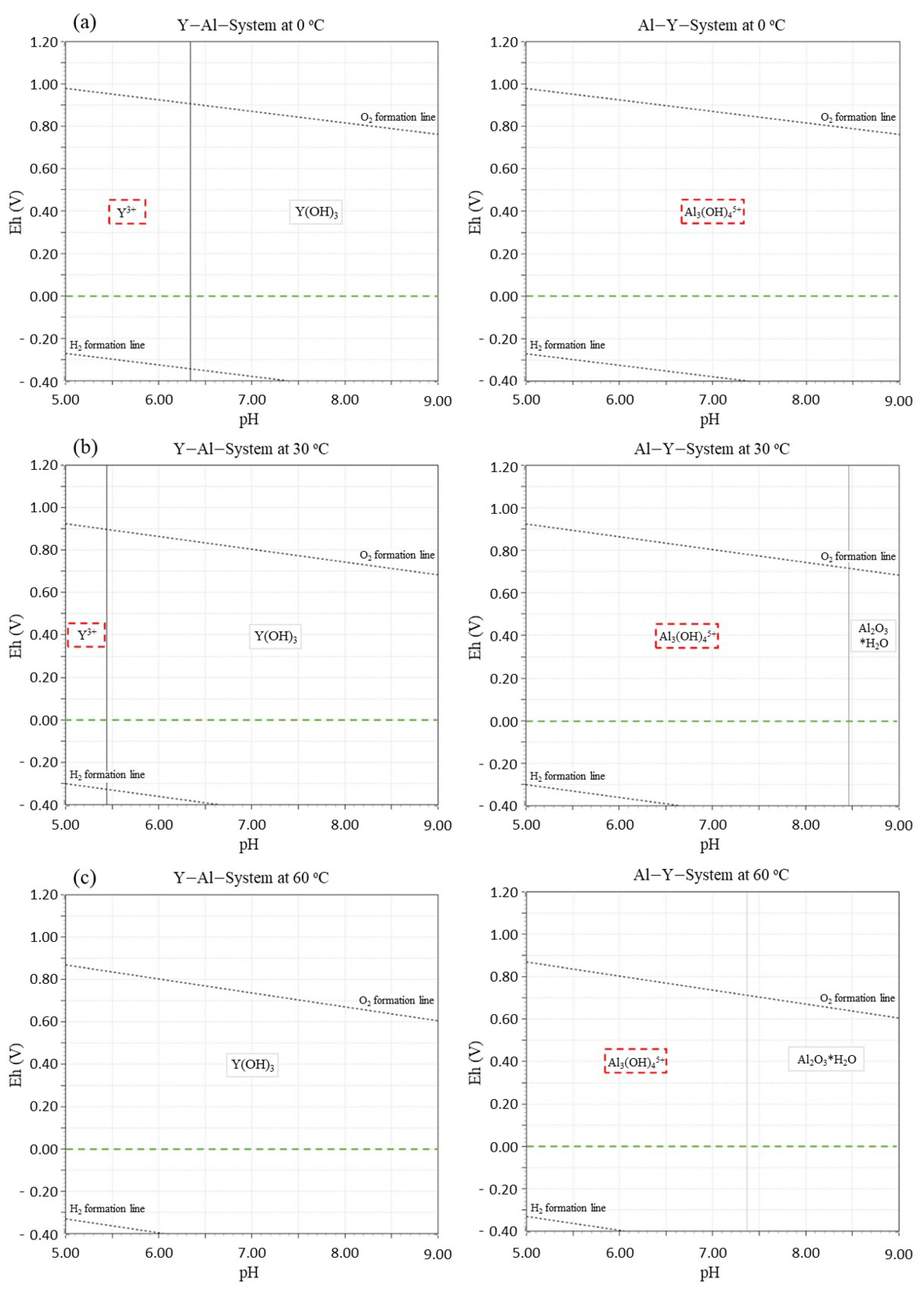

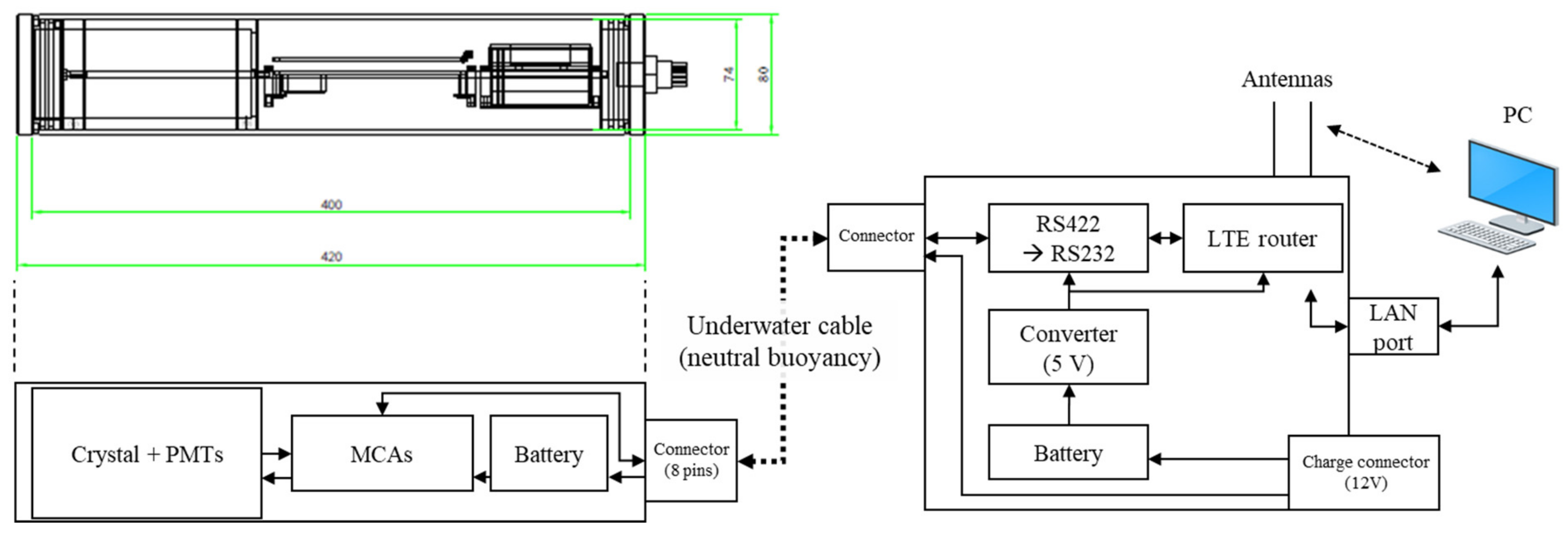

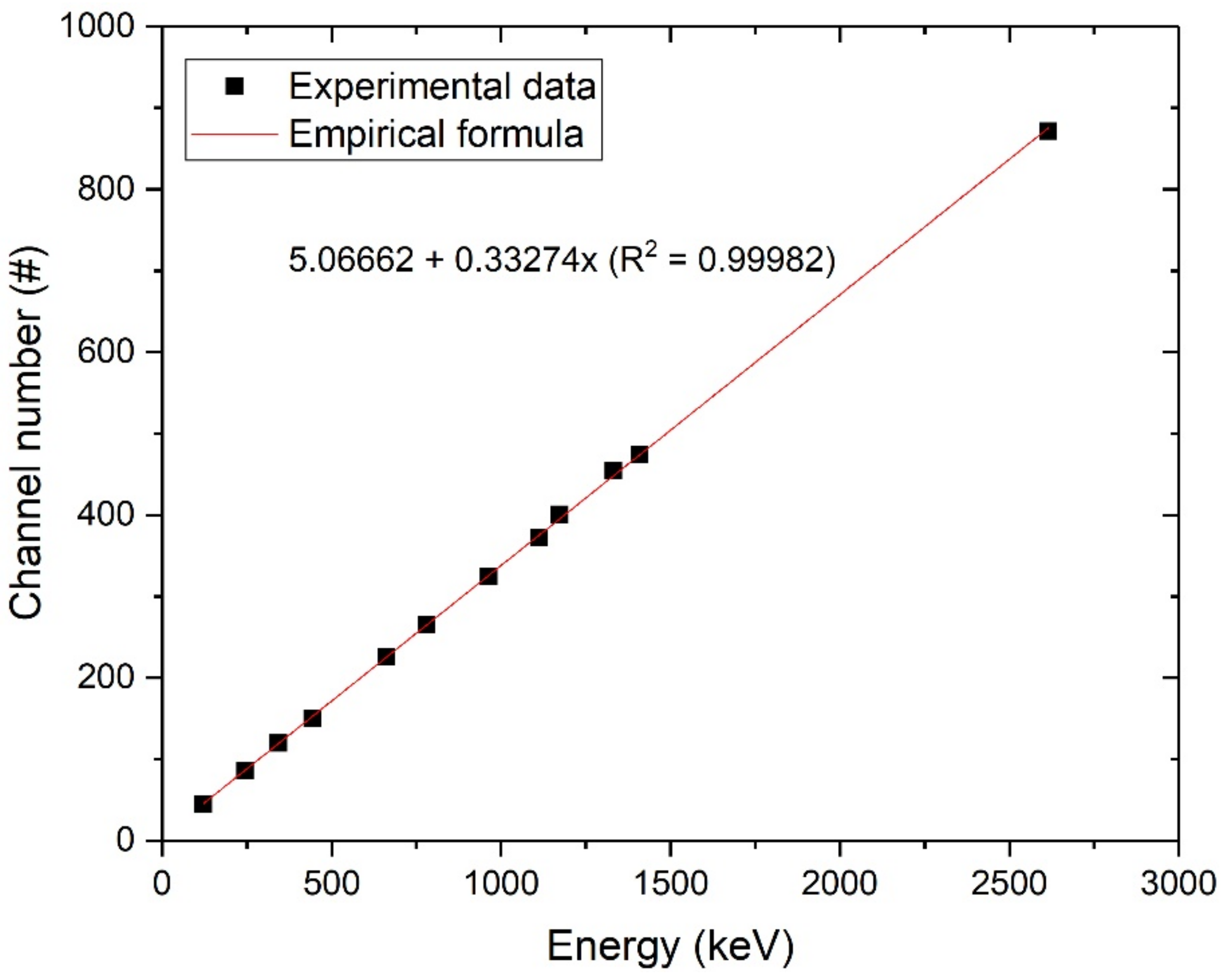
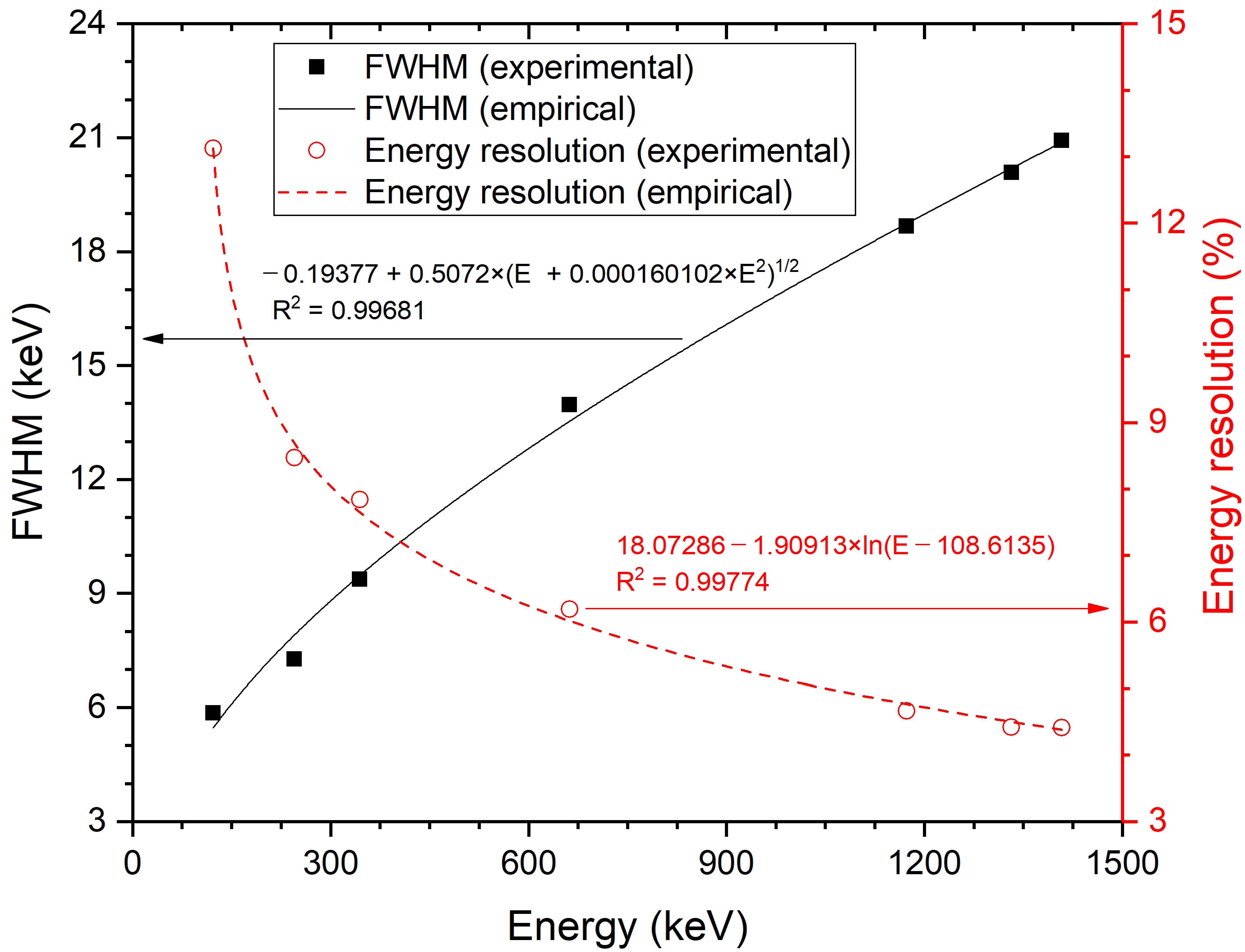
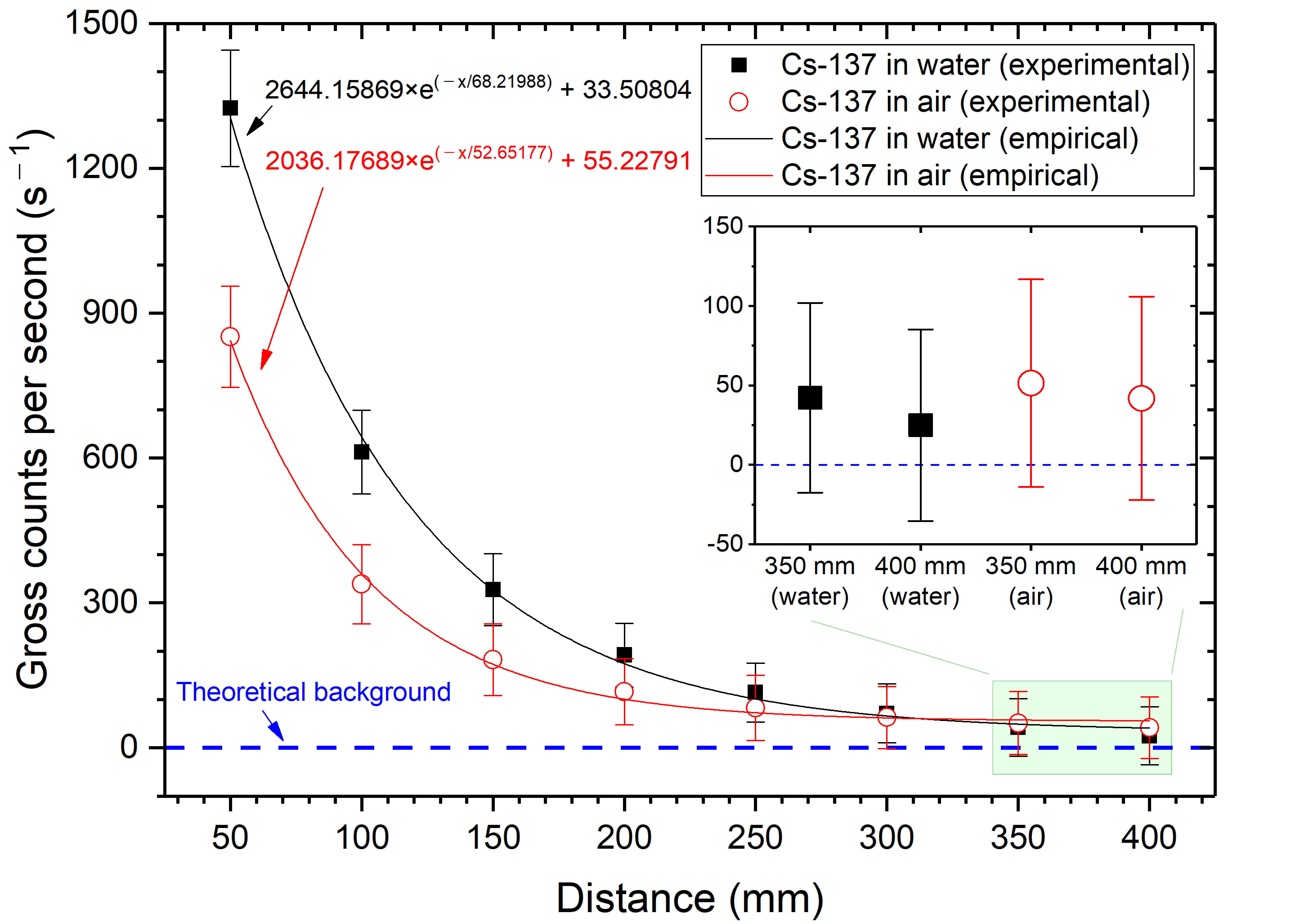


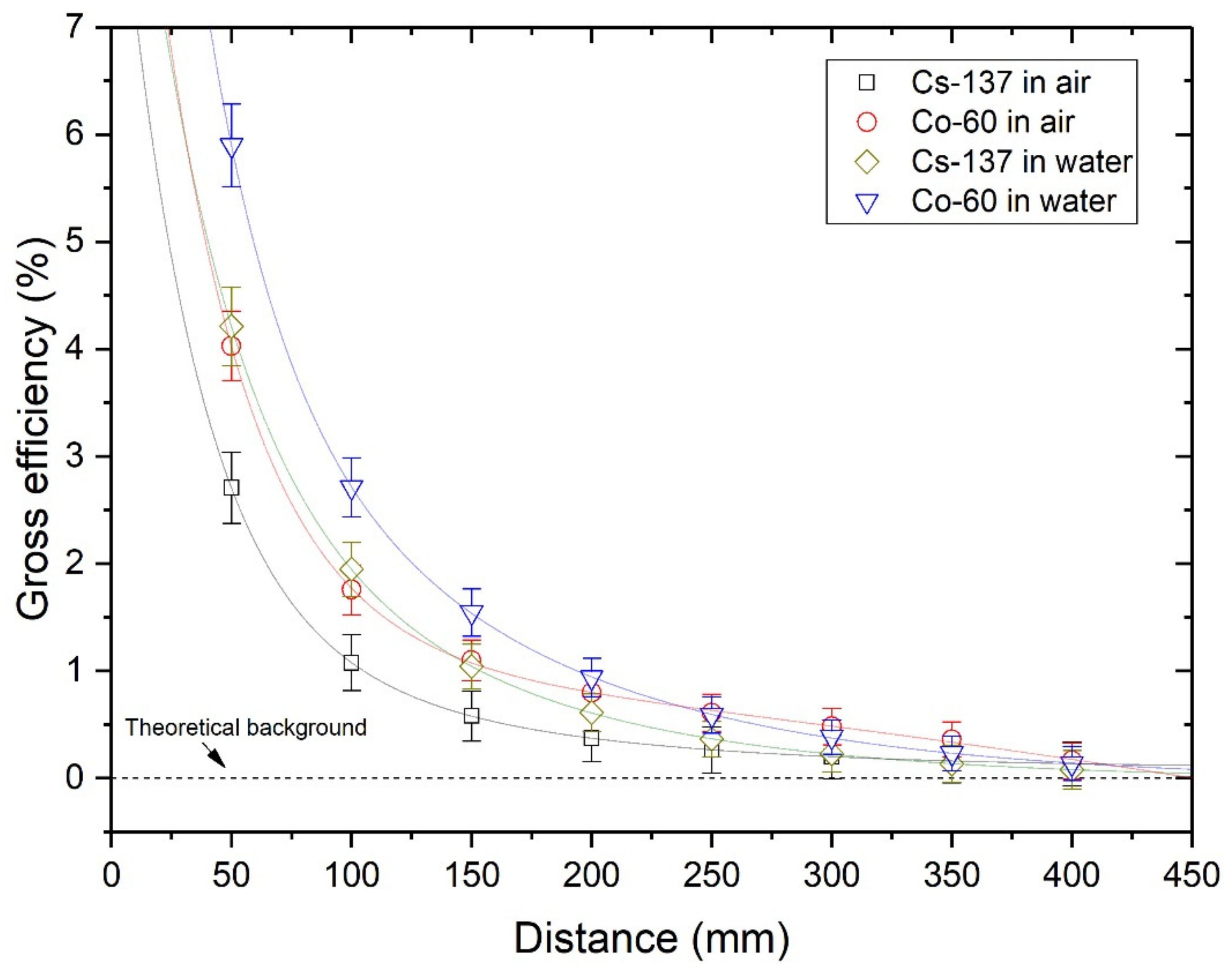

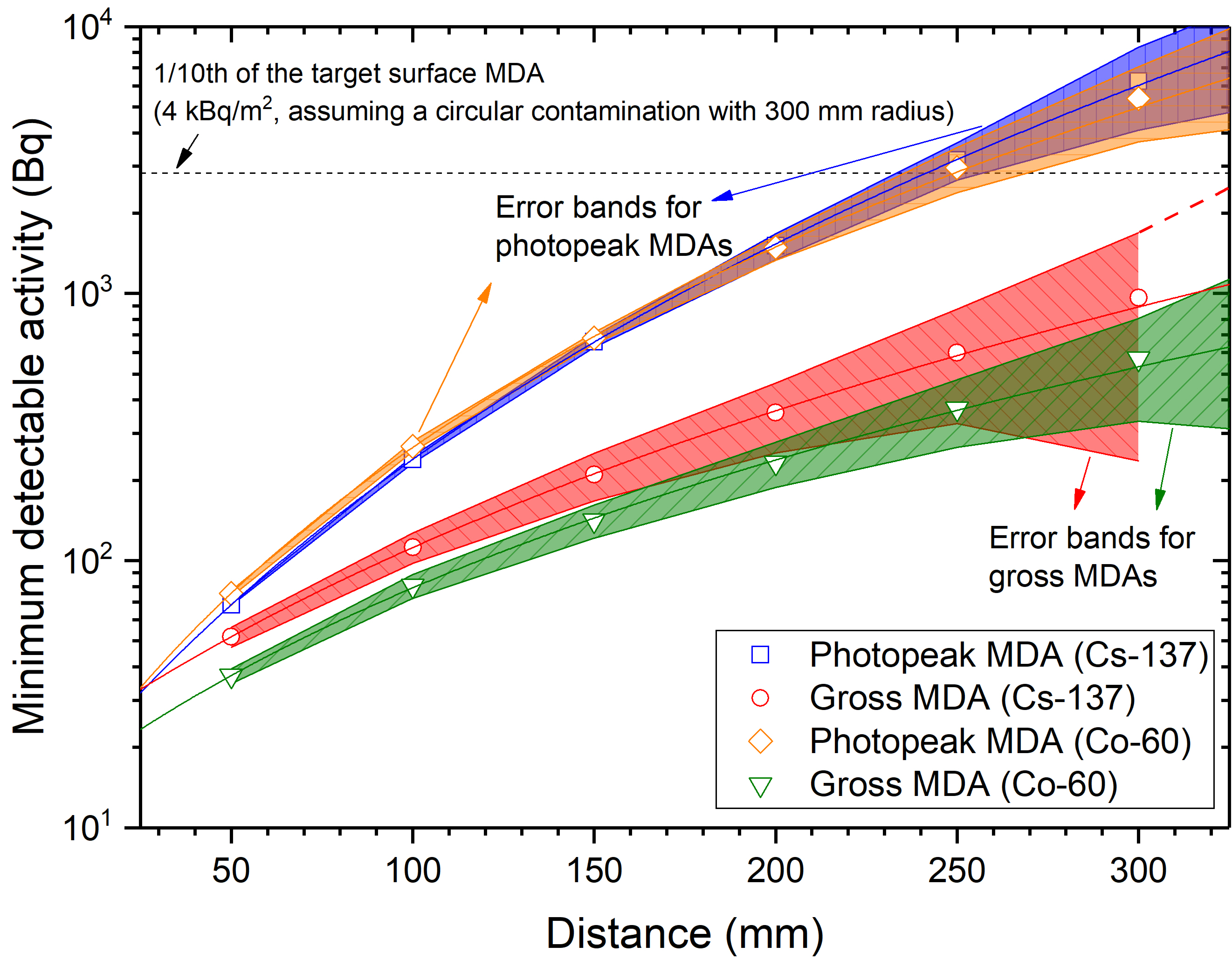
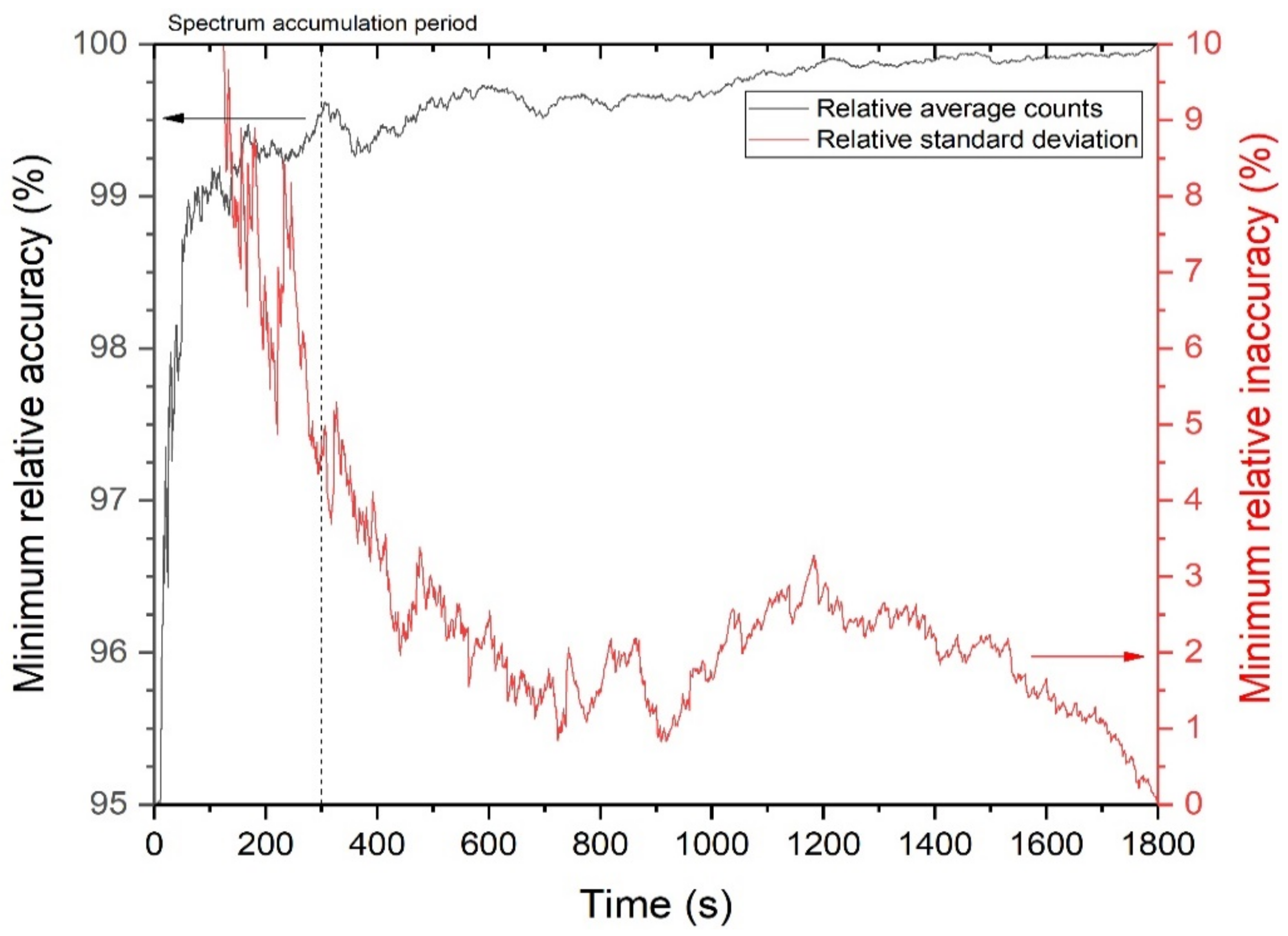
| Criteria | Requirements |
|---|---|
| mass and size | ROV-deployable and hand-held size (<3 kg) |
| data timeliness | gamma-ray spectrum for every 300 s gross counts for every 1 s |
| MDA target (nuclide) | 40 kBq/m2 (gross, surface contamination) |
| energy range | up to 3 MeV (1024 energy channels) |
| operating time | at least 24 h without charging |
| operating temperature | 0–60 °C |
| operating salinity | up to 3.5 wt% |
| operating pH (lifespan) | 5.0–9.0 (>1 yr) |
| operating pressure | up to 20 bar (~200 m depth) |
| YAlO3(Ce) | Gd3Al2Ga3O12(Ce) | NaI(Tl) | |
|---|---|---|---|
| emission maximum (nm) | 370 | 520 | 410 |
| density (g/cm3) | 5.37 | 6.63 | 3.67 |
| hygroscopicity | no | no | yes |
| cleavage plane (Miller index) | none | none | <100> |
| scratch hardness (Mohs) | 8.5 | 8 | 2 |
| radiation hardness (Gy) | 10 | ||
| neutron sensitivity | no | yes | yes |
| decay time (ns) | 25–30 | 50–150 | 230 |
| light yield (photons/keV) | 25 | 50 | 40 |
| photoelectron yield (phe/keV) | 3.5–4 | 6.2 | 10 |
| ratio of photoelectron/light (phe/photons) | 0.14–0.16 | 0.124 | 0.25 |
| Specification Parameter (unit) | Value |
|---|---|
| operating temperature (°C) | −30 to +50 |
| spectral response (nm) | 300 to 650 |
| quantum efficiency (%, at 390 nm and at 25 °C) | 30 |
| max. supply voltage (V) | 1500 |
| voltage gain | 2.7 × |
| dark current (nA) | 2–20 |
| rise time (ns) | 7.3 |
| transit time (ns) | 49 |
| pulse linearity (mA, ±2% deviation) | 1 |
| Cs-137, Gross | Cs-137, Photopeak | Co-60, Gross | Co-60, Photopeak | |
|---|---|---|---|---|
| 5 mm | 2.39 ± 0.360 | 1.11 ± 0.023 | 2.01 ± 0.208 | 1.20 ± 0.031 |
| 10 mm | 4.27 ± 1.170 | 1.25 ± 0.036 | 2.91 ± 0.482 | 1.26 ± 0.051 |
| 15 mm | 6.53 ± 2.945 | 1.33 ± 0.047 | 3.65 ± 0.816 | 1.29 ± 0.044 |
| 20 mm | 9.20 ± 6.041 | 1.46 ± 0.099 | 4.19 ± 1.224 | 1.31 ± 0.103 |
| 25 mm | 11.86 ± 11.056 | 1.56 ± 0.106 | 4.71 ± 1.879 | 1.36 ± 0.142 |
| 30 mm | 14.99 ± 19.075 | 1.71 ± 0.220 | 5.33 ± 2.905 | 1.40 ± 0.153 |
| 35 mm | 16.67 ± 30.138 | 2.04 ± 0.359 | 5.93 ± 4.898 | 1.50 ± 0.267 |
| 40 mm | 18.66 ± 50.839 | 2.67 ± 1.027 | 10.70 ± 16.419 | 1.55 ± 0.426 |
| Cs-137 | Co-60 | |
|---|---|---|
| 5 mm | 2.15 ± 0.326 | 1.68 ± 0.178 |
| 10 mm | 3.41 ± 0.940 | 2.31 ± 0.394 |
| 15 mm | 4.92 ± 2.229 | 2.83 ± 0.641 |
| 20 mm | 6.28 ± 4.149 | 3.21 ± 0.970 |
| 25 mm | 7.58 ± 7.084 | 3.46 ± 1.426 |
| 30 mm | 8.77 ± 11.220 | 3.82 ± 2.123 |
| 35 mm | 8.16 ± 14.829 | 3.95 ± 3.337 |
| 40 mm | 7.00 ± 19.263 | 6.92 ± 10.794 |
Publisher’s Note: MDPI stays neutral with regard to jurisdictional claims in published maps and institutional affiliations. |
© 2021 by the authors. Licensee MDPI, Basel, Switzerland. This article is an open access article distributed under the terms and conditions of the Creative Commons Attribution (CC BY) license (http://creativecommons.org/licenses/by/4.0/).
Share and Cite
Lee, C.; Kim, H.R. Gamma-Ray Sensor Using YAlO3(Ce) Single Crystal and CNT/PEEK with High Sensitivity and Stability under Harsh Underwater Conditions. Sensors 2021, 21, 1606. https://doi.org/10.3390/s21051606
Lee C, Kim HR. Gamma-Ray Sensor Using YAlO3(Ce) Single Crystal and CNT/PEEK with High Sensitivity and Stability under Harsh Underwater Conditions. Sensors. 2021; 21(5):1606. https://doi.org/10.3390/s21051606
Chicago/Turabian StyleLee, Chanki, and Hee Reyoung Kim. 2021. "Gamma-Ray Sensor Using YAlO3(Ce) Single Crystal and CNT/PEEK with High Sensitivity and Stability under Harsh Underwater Conditions" Sensors 21, no. 5: 1606. https://doi.org/10.3390/s21051606
APA StyleLee, C., & Kim, H. R. (2021). Gamma-Ray Sensor Using YAlO3(Ce) Single Crystal and CNT/PEEK with High Sensitivity and Stability under Harsh Underwater Conditions. Sensors, 21(5), 1606. https://doi.org/10.3390/s21051606






